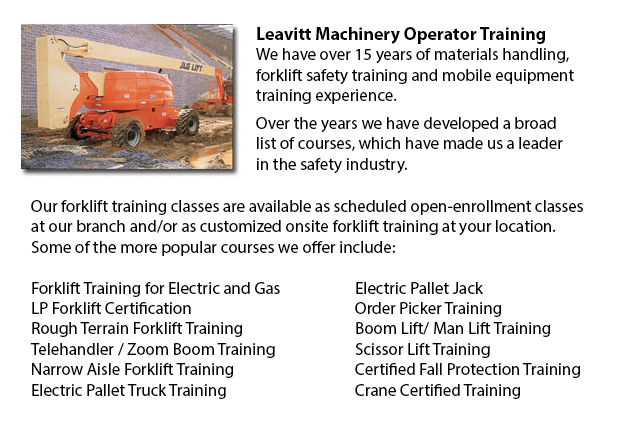
Brampton Aerial Lift Safety Training - Each and every year, there are approximately 26 construction deaths attributed to the utilization of aerial lifts. Most of the craftsmen killed are electrical workers, laborers, carpenters, painters or ironworkers. Most deaths are caused by electrocutions, falls and tip-overs. The greatest hazard is from boom-supported lifts, like for instance bucket trucks and cherry pickers. The majority of the deaths are connected to this particular type of lift, with the rest involving scissor lifts. Other risks consist of being thrown out of a bucket, being struck by falling things, and being caught between the guardrail or lift bucket and a thing, like a joist or steel beam.
The safe operation of an aerial lift requires a check on the following items prior to making use of the device: emergency and operating controls, safety devices, personal fall protection gear, and tires and wheels. Inspect for possible leaks in the air, fuel-system, hydraulic fluid. Check the device for loose or missing components.
The place where the device will be used should be thoroughly checked for potential dangers, such as bumps, holes, drop-offs and debris. Overhead power lines must be avoided or closely monitored. It is recommended that aerial lift devices be used on surfaces that are stable and level. Never work on steep slopes that exceed slope limitations which the manufacturer specified. Even on a level slope, brakes, wheel chocks and outriggers must be set.
Employers are needed to provide maintenance mechanics and aerial lift operators with the correct manuals. Operators and mechanics have to be trained by a certified individual experienced with the applicable type of aerial lift.
Aerial Lift Safety Tips:
o Close lift platform chains or doors prior to operating.
o Climbing on and leaning over guardrails is prohibited. Stand on the floor of the bucket or platform.
o Stay within manufacturer's load-capacity restrictions.
o When working near traffic, utilize correct work-zone warnings, like for instance cones and signs.
If correct procedures are followed, electrocutions are avoidable. Stay at least ten feet away from any power lines and certified electricians should de-energize and/or insulate power lines. Individuals working need to utilize personal protective tools and equipment, like for instance insulated bucket. Nonetheless, an insulated bucket does not protect from electrocution if, for instance, the person working touches another wire providing a path to the ground.
Falls are avoidable if the individual working remains secure in guardrails or inside the bucket by using a full-body harness or a positioning device. If there is an anchorage within the bucket, a positioning belt with a short lanyard is acceptable.
By following the manufacturer's instructions, tip-overs can be avoided. Never drive the lift platform when it is elevated, unless otherwise specified by the manufacturer. Adhere to the device's horizontal and vertical reach restrictions, and never go beyond the load-capacity that is specified.
-
Brampton Aerial Boom Lift Ticket
Brampton Aerial Boom Lift Ticket - Aerial lift trucks might be used to accomplish several different tasks executed in hard to reach aerial places. Many of the tasks associated with this style of jack include performing routine maintenance on building... More -
Brampton Aerial Lift Train the Trainer
Brampton Aerial Lift Train the Trainer - The Aerial Lifts Train the Trainer Certification Program would teach trainers how to efficiently train operators in safe industrial mobile equipment operation. Trainers are provided with in-depth instruction o... More -
Brampton Zoom Boom Training
Brampton Zoom Boom Training - Zoom Boom Training is intended to train operators on variable reach forklifts. The goals of the training are to be able to impart an understanding of the physics of the machinery, and to be able to outline the operator's... More -
Brampton Heavy Equipment Operator Training
Brampton Heavy Equipment Operator Training - Heavy equipment operator training facilities that provide good standards within the industry, providing field performance work and additional machinery training are really sought after training features. S... More -
Narrow Aisle Forklift / Order Picker Training / Electric Pallet Jack / Electric Pallet Truck Training in Brampton
A pallet haul is equipment built in particular for moving pallets of irregular weights and dimensions. They may be used in conjunction with cranes, forklifts and other heavy duty equipment as an appendage piece or to be employed on their own. Pallet... More -
Brampton Overhead Crane Safety Training
Brampton Overhead Crane Safety Training - Overhead crane safety training equips operators with knowledge and skills regarding crane safety measures, accident avoidance, materials handling, and equipment and stock protection. Trainees will learn the k... More -
Brampton Crane Safety Training
Brampton Crane Safety Training - Companies and crane drivers have to know the problems associated to crane safety. Legislation provides rules for the safe maintenance, operation and inspection of lifting machines across North America. Crane Safety co... More -
Brampton Telehandler Training
Brampton Telehandler Training - Telescopic handlers normally known as telehandlers for short, are a really popular piece of heavy construction machinery. They are usually utilized in the construction and agricultural trades. These machines have farth... More

Forklift Certification Brampton
TOLL FREE: 1-888-254-6157
Brampton, Ontario
forkliftcertificationbrampton.com
Email Us
About Us


